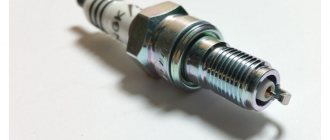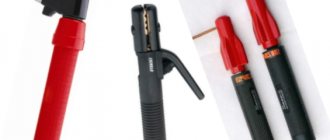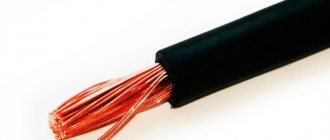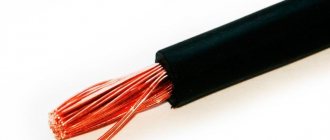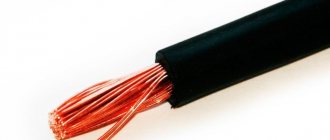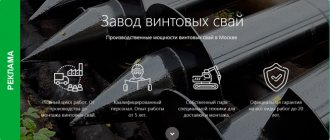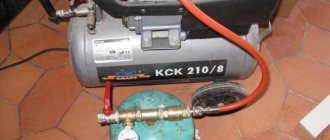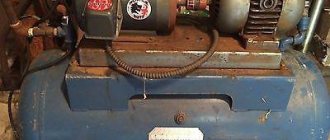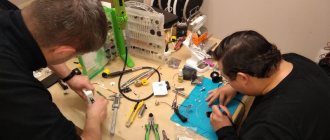The compressor used to equip the sandblasting machine is the most important element, the correct choice of which largely determines the efficiency of the entire system. The technical characteristics of this device also have a direct impact on the performance of the processing performed and on such an important parameter as the consumption of abrasive material.
A sandblasting unit and a compressor are two essential components of one metalworking system
So that savings do not turn into losses
In the total cost of a set of equipment for sandblasting, the compressor is the most expensive link. Therefore, often, in an attempt to save money, compressors with the very minimum performance or even lower than those required by sandblasting equipment manufacturers are purchased. As a result, the speed of work is reduced, the consumption of abrasive in terms of the cleaning area increases, the deadlines for fulfilling orders are disrupted and costs increase. Therefore, when choosing a compressor, you should first take into account the volume of expected work and the timing of its completion.
Below is a table of the relationship between pressure, compressed air consumption, abrasive consumption and cleaning speed. It is very difficult to calculate exact consumption indicators, since they depend on the nature of the surface being treated, the height of supply of the air-abrasive mixture, the degree of surface contamination and the personal skill of the operator, but the numbers in the table provide guidelines for calculations and understanding the relationships between indicators.
What is more important: pressure or air volume?
Both characteristics are important, however, the quality of the air-abrasive mixture and the cleaning speed depend most on the performance (the volume of compressed air per unit of time, for example, l/min). Higher air volume allows the use of larger diameter nozzles, increasing the cleaning spot and speed.
The pressure for different types of work ranges from 3-5 bar when cleaning stone, brick, concrete, 5-8 bar for metal processing and sometimes 9-12 bar for removing thick-layer and abrasion-resistant coatings. In cases where it is necessary to supply an air-abrasive mixture at a distance of over 60 meters, a pressure of 9-12 bar is recommended. But whenever possible, you should try to use the minimum length of the abrasive blasting hose, and cover the main distances to the cleaning zone by increasing the length of the compressed air supply hose, since the pressure loss in the abrasive blasting hose will always be significantly higher than in the air hose.
The compressed air consumption of most pressure-type sandblasting machines from the most common manufacturers ranges from 2.5 to 17 cubic meters/min.
Choosing the right hoses
The equipment of the apparatus plays a major role in the formation of the final parameters of the air-abrasive sandblast jet. These are hoses, various connecting elements, connectors, and adapters. To ensure that the compressor power is used optimally, it is recommended:
- do not allow the diameter of the air passage channel to change along the route;
- minimize the number of transition elements;
- use durable, non-kink hoses with a diameter that is 3-4 times larger than the working diameter of the nozzle.
The length of the hose from the air station to the sandblasting gun should be kept to a minimum. A mobile industrial compressor necessarily takes this feature into account.
If we are talking about a semi-handicraft installation, it is recommended to increase the length of the hoses by extending the hose running from the compressor to the abrasive-air mixture mixing unit. You can further increase productivity, reduce downtime and obtain the desired, stable pressure for sandblasting by choosing the type of supercharger.
Piston or screw?
When carrying out sandblasting work, it is not recommended to use piston compressors. This is primarily due to the pulsation of compressed air, as a result of which the abrasive unevenly distributed in the compressed air clumps into large lumps, reduces the pressure and the nozzle begins to “spit.” It is possible to completely avoid pulsation only if the performance of the piston compressor exceeds the consumption of the sandblaster and a receiver (air collector) is included in the system. Also, piston compressors are most often designed for short (“ragged”) operating modes due to the inherent design of the cooling system and are characterized by a large removal of compressor oil.
Screw compressors are the most common type for sandblasting work worldwide, as they are capable of long-term and continuous supply of compressed air to equipment with very little pressure drop. Moreover, they are more economical both in maintenance and operation.
Varieties
There are various models of equipment in stores. To choose a compressor for sandblasting, you need to know what types they are divided into. There are two types of compresses, which are classified according to the type of action:
- piston;
- screw.
Based on the type of power supply, there are two types of equipment:
- electrical;
- gasoline and diesel.
Piston
Piston compressors are considered the most common and popular. They are suitable for small amounts of work. They are used in garages, car services, and own workshops. They have certain features:
- The air is not supplied in a uniform flow, but in jerks.
- When choosing a piston sandblasting machine, preference should be given to oil-based models. Oil droplets may enter the air supply hose.
The design overheats during prolonged operation and requires frequent shutdown to cool down. As standard, this equipment is not suitable for connection to a sandblaster. To improve performance and increase efficiency, you need to purchase a compressor with an assembled air station. This design stabilizes the pressure, allows the engine to stop on its own to cool down and prevents oil from entering the air channel.
Screw
Screw-type compressor units supply air evenly. There are no jerks that prevent the surfaces from being evenly treated with abrasive material. Other features of the screw apparatus:
- Stable operation for a long period of time.
- No additional maintenance or fine adjustments are required.
- Does not emit strong vibrations during operation.
However, despite such advantages, screw installations have not become widespread due to their size and cost. Most often, screw models are used to power several sandblasting machines.
Electrical
They are considered the most popular models that can be found on sale. However, equipment connected to the general power supply network requires a large amount of energy when processing massive structures. Because of this, the use of electrical devices is only advisable for small workshops, private houses and garages.
Electric compressor
Diesel and petrol
Equipment powered by liquid fuel has a number of advantages:
- Operation is not affected by low temperature. Diesel systems have a special start button for winter.
- When processing massive structures, they are more economical than electrical devices.
- Does not require a network connection. Can work indoors without electricity
Equipment running on diesel and gasoline is more powerful than electric models. Also, we must not forget about the cooling system. When using internal combustion engines, it is more thoughtful and allows you to work with the equipment for a long time without turning it off.
Diesel or electric?
If work is carried out on-site (without the ability to connect to the electrical network), then most often the only option is to use a diesel compressor. As a rule, a diesel compressor is equipped with a performance control system: when compressed air consumption decreases, the speed is reduced, and when it increases, on the contrary, it rises. Due to the design, this solution is much easier to implement than on compressors with an electric drive, since in order to achieve a similar effect, much more expensive drive frequency control units are installed on them.
Electric compressors, compared to diesel ones, are more economical and, due to their design features, are much simpler and cheaper to operate and maintain. For field work, there are mobile models mounted on a chassis. When sandblasting, compressors with engine power from 22 to 100 kW or more are used, which may impose restrictions when connecting to electrical networks.
Before buying a diesel compressor, check whether conditions allow you to use a mobile electric compressor instead; if so, then you should give preference to the second one.
Room for working with a sandblasting machine
When working with a sandblasting machine, it is a good idea to take care of creating the necessary conditions in the workroom. The main enemy of sandblasting is excess moisture, since when sandblasting is carried out, productivity can be significantly affected by its humidity. Therefore, first of all, care is taken to remove excess moisture from the room. Also for this purpose, professional sandblasting machines are equipped with air dryers, which is taken and supplied from the compressor to the working gun.
An equally important factor is the purity of the air from impurities. In addition to cleaning it in the workroom, filtration is used directly in the devices. The suction flow is cleared of oil and other impurities, which ensures better mixing with sand and supply to the working area.
Also, the sandblasting chamber should be able to be easily cleaned of sand residues. If you work with sandblasting at an amateur level, then you should choose a room for this where the sand will not interfere. After all, it will be very difficult to completely remove it. It is best to equip a special sealed chamber for this work and use it only for these purposes.
How to avoid condensation?
Moisture-oil condensate formed in the pipeline and in the equipment can seriously reduce the productivity of the sandblasting machine, and in some cases, completely stop its operation. High-end sandblasting equipment is always equipped with cyclone separators (moisture-oil separators), but they only help remove condensed liquid and cannot completely prevent condensate from getting into the abrasive. When wet, most abrasives cake and lose their free-flowing properties, this negatively affects the quality of dosing, reduces the cleaning speed and increases abrasive consumption. Metal shot in the presence of moisture oxidizes and wears out faster. And getting condensed compressor oil onto the surface to be cleaned is also extremely undesirable.
To eliminate the bulk of the condensate, in most cases a compressed air cooler and a cyclone separator or coalescent filter are sufficient, but in some cases this is not enough and the use of refrigerated dryers is recommended. This type of equipment can be either built into compressors or separately mounted.
Scope of sandblasting machines
You should start with the area where sandblasting is used. The most famous application of this processing method is for cleaning metal during body repair or when painting car rims. Devices for such processing have high pressure, with the help of which a sand jet removes the remains of old paint, soil, rust or scale from the metal surface.
Sandblasted metal lasts much longer after painting, largely due to the fact that such cleaning is better than other methods of removing metal coating. Small grains of sand cut into the surface being treated at high speed, thereby knocking down even those traces of corrosion that are located in small pores or cracks, where they are difficult to reach with traditional tools.
In addition to the quality of cleaning from old coating and traces of corrosion, sandblasting leaves behind a smoother surface. There are no scratches that occur after using brush cleaning, or using sandpaper with large abrasive particles. This makes it much easier to apply the first layer of primer and improves the quality of its adhesion to the metal.
In addition to body repair, sandblasting is widely used in other areas of human activity. This is how large ships, parts and products are cleaned in factories. In addition to metal, this processing method is also applicable to other types of materials, for example, for cleaning wood, brick or concrete products.
Sandblasting machines are used to create specific effects on wood or glass. Wooden products after processing can acquire all kinds of patterns. Sandblasting is used to frost glass, which is used for decorative purposes, for example, for engraving in the form of different patterns. Some sandblasting machines can be used to drill holes in glass, which can be round or other shapes.
Which compressor will last the longest?
During the sandblasting process, as a rule, a large amount of dust consisting of aggressive abrasive particles is formed. The ingress of such dust into the screw compressor units significantly reduces their service life, therefore, during work, it is recommended to remove compressors from the cleaning area by 40-60 meters, if possible. Many compressor manufacturers can equip stations with additional filters as an option, so try to choose compressors with such filters, this also increases the life of the screw units.
Choose compressors from manufacturers that have a wide network of service centers. Try to work with authorized suppliers who have their own service departments. Pay attention not only to the price of the compressor.
Neutralization of oil
If oil gets into the base, it can cause a variety of unpleasant consequences. To remove oil, a special trap is installed.
The unit in question is usually installed at the outlet of the sandblasting compressor. Due to this, the efficiency of this installation is significantly increased.
New compressor or used?
When buying a previously used compressor, be prepared, first of all, for the fact that the indicators stated in the technical documentation in practice may differ significantly from the real ones. This is due to natural wear and tear of equipment and a decrease in efficiency. You can only find out the current compressor performance by taking measurements using a flow meter.
For diesel compressors that have been in service for 3 or more years, increased fuel consumption is relevant, and, as a result, increased costs of work. Maintenance and repair costs also increase, which also increases the cost of cleaning.
When planning work on large objects, you cannot rely only on supported equipment. A high level of risks associated with equipment failure and downtime for maintenance and repair can lead to missed deadlines for work, production downtime and an unplanned increase in costs not taken into account in estimates or calculations of the cost of products.
Leading manufacturers of compressor equipment state that the normal operation life of compressors is in the range of 7-10 years. If you decide to purchase a used compressor, then consider these numbers. Compressors over 10 years old, which fill our market, are an impractical and very risky investment.
Sandblasting gun for compressor. Abrasive processing at home
If you are engaged in repair and restoration work or own a small auto repair shop, then you cannot do without a sandblasting gun for your compressor. The variety of models in most cases allows you to make a completely informed choice, simultaneously increasing the scope of application of the existing compressor installation.

